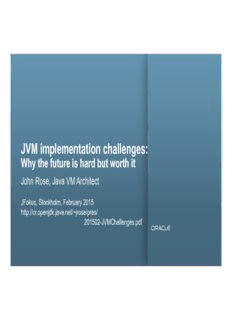
JVM Challenges PDF
Preview JVM Challenges
JVM implementation challenges: Why the future is hard but worth it John Rose, Java VM Architect JFokus, Stockholm, February 2015 http://cr.openjdk.java.net/~jrose/pres/ 201502-JVMChallenges.pdf 1 Copyright © 2015, Oracle and/or its affiliates. All rights reserved. The following is intended to outline our general product direction. It is intended for information purposes only, and may not be incorporated into any contract. It is not a commitment to deliver any material, code, or functionality, and should not be relied upon in making purchasing decisions. The development, release, and timing of any features or functionality described for Oracleʼs products remains at the sole discretion of Oracle. 2 Copyright © 2015, Oracle and/or its affiliates. All rights reserved. Purposes of this talk http://cr.openjdk.java.net/~jrose/pres/201502-JVMChallenges.pdf § Speak about JVM architecture, especially its futures § Propose key goals (idealized, a bit) for the JVM design § Point out obstacles that thwart those goals § Show how the OpenJDK is making progress on the goals § Stop talking after 40 minutes … having teased everyone and informed no one Audience = designers & implementors of VMs & languages (up-stack users may find some of this talk uninteresting) 3 Copyright © 2015, Oracle and/or its affiliates. All rights reserved. VM DESIGN 4 Copyright © 2015, Oracle and/or its affiliates. All rights reserved. JVM Vision Platform for language execution § Java = simple, object oriented, distributed, interpreted, robust, secure, architecture neutral, portable, high performance, multithreaded, dynamic language – Gosling, “Java: An Overview” (1995) § JVM = portable execution platform featuring uniform objects, native threads, interpreted/compiled execution , profile- (a.k.a. “mixed-mode”) driven speculative optimization with deoptimization — for Java – Sun, “The Java HotSpot Virtual Machine” (2001) 5 Copyright © 2015, Oracle and/or its affiliates. All rights reserved. JVM Vision Not just for Java § “Any language with functionality that can be expressed in terms of a valid class file can be hosted by the Java virtual machine.” – JVM Specification First Edition (1997), preface § “In the future, we will consider bounded extensions to the Java Virtual Machine to provide better support for other languages.” § “The Java SE 7 platform in 2011 made good on [this] promise.” – JVM Specification, J2SE 7 Edition (2013) § In SE 8, Java used “polyglot” invokedynamic to implement closures. 6 Copyright © 2015, Oracle and/or its affiliates. All rights reserved. What’s in a JVM? Data & code, safe & portable § Data structures connected by managed pointers, dynamically typed – Computation with primitives and objects (methods, classes, interfaces) § (Byte-)code that runs fast (hardware speed) without preprocessing – Name binding and optimization are deferred; lazy load and lazy link § Safe, type-enforcing, robust, secure – Limits damage caused by error or malice, bug-resistant § Portable, architecture-neutral, multiprocessing, large memory – Keeps pace with hardware technologies, grows with data paths & memory 7 Copyright © 2015, Oracle and/or its affiliates. All rights reserved. Clever JVM moves § Data: GC, uniform reflectability, primitives with optional boxing § Code: JIT compilation, mixed-mode execution; profiling, deoptimization § Safe: Redundant checks (verifier); abnormalities throw exceptions § Portable: Clear specifications, hidden details; long-term compatibility § The best moves are invisible, or can safely be neglected by the user. Result: A simple user experience despite the complex technology. 8 Copyright © 2015, Oracle and/or its affiliates. All rights reserved. Reality check (or, how do we know when we win?) § Data: Easy to understand, flexible, regular, compact (in memory) § Code: Efficiently encodes source code meaning, runs fast § Safe: Doesn’t crash, hard to crack, no need for “snake pit” maps § Portable: Gets the best out of every major CPU and system 9 Copyright © 2015, Oracle and/or its affiliates. All rights reserved. Reality check (searching and fearless inventory, anyone?) § Data? Diffuse (too many indirections); racy; weak genericity (hard to tune) § Code? Compilation unit size is too small; 16-bit limits; Java-specific § Safe? The JVM is complex (~1M LOC) § Portable? 32-bit array size; 64-bit primitive size; dinosaur threads “By seeking and blundering we learn.” — Goethe τὸν πάθει µάθος θέντα — “Suffering makes learning.” — Aeschylus 10 Copyright © 2015, Oracle and/or its affiliates. All rights reserved.
Description: